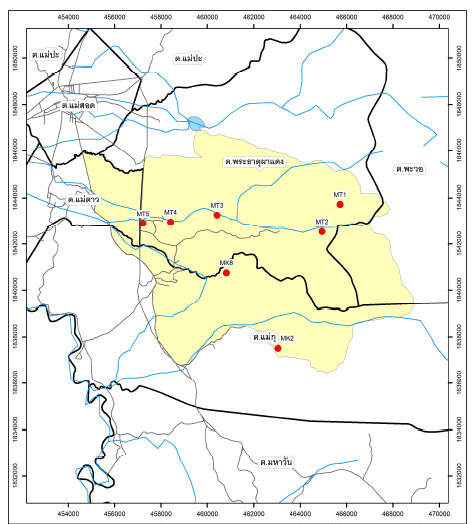Distribution of aquatic insect (Insect, Trichoptera) relation to water quality in Mae Tao watershed
Main Article Content
Abstract
A study concerning the relationship between physico-chemical water quality parameters
and the diversity of aquatic insect larvae (Trichopteran) was conducted in Mae Tao and Mae Ku
watersheds during February to December 2011. Seven sampling sites (MT1-MT5, MK2, MK8)
were selected. A total of 3,442 trichopteran individuals belonging to 10 family and 18 genera
were found. The family Hydropsychidae had the highest abundance, followed by
Philopotamidae, Odontoceridae, and Leptoceridae, respectively. The Cheumatopsyche,
Hydropsyche, and Chimarra were the highest abundance genera in this study. The species
diversity index (H') was the highest in MT1 (0.842) followed by MT4 (0.79), MT3 (0.765),
MT2 (0.625), MT5 (0.611), MK2 (0.583), and MK8 was the lowest (0.352). The water and air
temperature in MT1 was correlated with the genus Mystacide, Ceraclea, Leptocerus, Marilia
and Anisocentropus. The water turbidity, nitrate-nitrogen, dissolved oxygen, pH, total dissolved
solids and alkalinity in MT3, MT4, MK2 and MK8 were correlated with the genus Setodes,
Goera, Helicopsyche and Orthrotrichia. The ammonia-nitrogen and sulphate in MT2 and MT5
were correlated with the genus Chimarra, Cheumatopsyche sp1, Cheumatopsyche sp2,
Potamyia, Hydropsyche, Oecetis and Macrostemum. The orthophosphate was correlated with
the genus Glossosoma and Diplectrona. Physico-chemical data and biological data revealed that
mostly the surface water quality in Mae Tao watershed was within the Type III of The Surface
Water Standard for Agriculture and Water Quality for Protection of Aquatic Resources. Further
long-term studies should be done to understand better and predict the hydrological changes and
population dynamics of the stream.
Article Details
Published articles are under the copyright of the Environment and Natural Resources Journal effective when the article is accepted for publication thus granting Environment and Natural Resources Journal all rights for the work so that both parties may be protected from the consequences of unauthorized use. Partially or totally publication of an article elsewhere is possible only after the consent from the editors.

